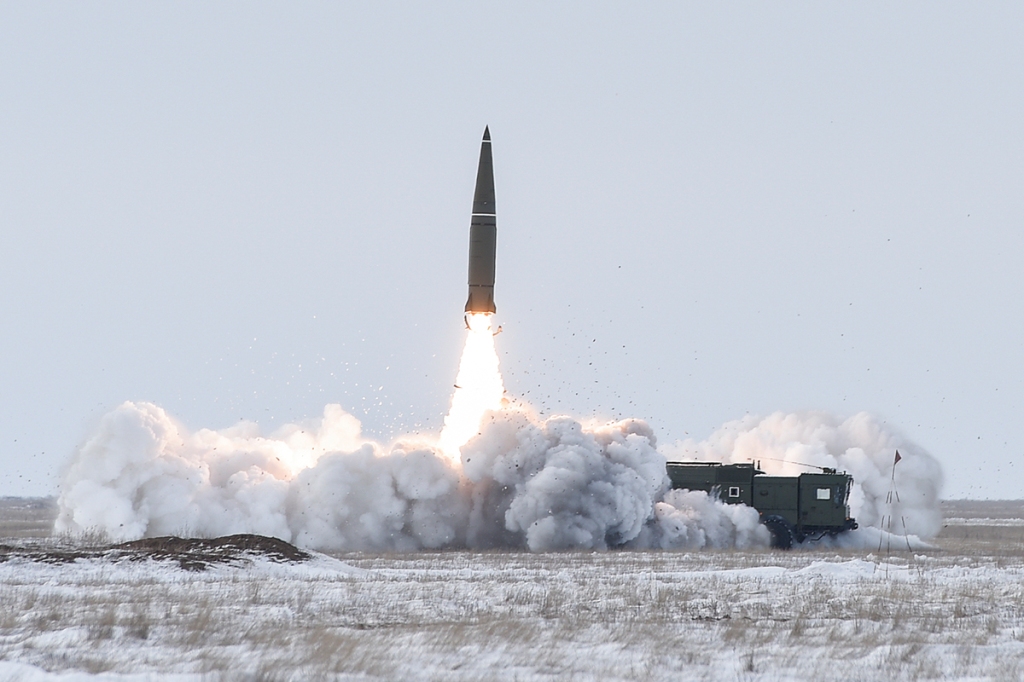
With Europe on the brink of war, concerns have been raised over the role of atomic weapons in a modern, great power conflict. Russia holds the largest known nuclear arsenal, with about 1,456 deployed nuclear weapons. With a well-developed nuclear triad, Russia’s nuclear policy consists of deterrence and ‘escalate to de-escalate’, a controversial yet potentially effective method to resolve a conflict rapidly.
Putin has recently ramped up his military presence in Ukraine, with reports of a purported false-flag incident underway. Moreover, many Iskander ballistic missiles have been placed in Russia and Belarus, all capable of delivering nuclear warheads.
Unless rapid advances and overwhelming firepower ensure Russia’s early victory, a war with Ukraine is likely to be a long, drawn-out process. Ukraine is deeply entrenched, and though its rolling plains do it no favors, Ukraine’s people have shown a serious commitment to defending their sovereignty from a Russian invasion. With materiel and economic support from the West, Ukraine can jeopardize Russia for decades, even if it were completely subjugated.
Yet despite the increased presence of American and British troops in continental Europe, it remains unlikely that NATO and Russia will fight head to head. Biden has repeatedly assured that troops are to protect NATO allies in Eastern Europe; the last thing the world needs is a new European land war.
But this is precisely where Putin’s strategy plays in; the deployment of low-yield nuclear weapons on the battlefield against a non-nuclear opponent, a major escalation in warfare.
By escalating against a nation without nuclear capabilities, Russia can strike with less fear of being matched; Ukraine cannot respond with nuclear weapons of its own. But neither can NATO; should Russia use a strategic counterforce (exclusively military targets) attack on Ukraine alone, there is little justification to respond in any nuclear capacity. While Russia would likely find itself the new pariah of the international community, direct military escalation would be impossible had Ukraine been the only target immediately affected.
Even if Russia were so bold as to strike Kyiv or Odesa with nuclear weapons, NATO still wouldn’t have the grounds for a nuclear response. At the same time, though a larger U.N. intervention would be justified, it would only give Putin more nuclear targets, potentially starting low-yield nuclear conflict in regions around Eurasia.
Hence, a Russian nuclear attack is likely to instead ‘freeze’ a conflict, allowing Russian troops to solidify the new border wherever they so desire. With Ukraine reeling in the aftermath of a nuclear attack, there would be little resistance to worry about: only the massive economic and political ramifications on the international stage.
Such an action would usher a new era of warfare, doing away with deterrence and instead of creating a world where escalation is carefully measured. Direct communications between adversaries would be paramount, as would protecting these networks from cyberwarfare. A communication breakdown would leave both sides flying blind, not knowing how a potential escalation was developing.
In the worst-case scenario, where NATO and Russia one day fight a land war in Europe, low-yield nukes would fall like rain in Poland, Kalinigrad, and Belarus, hitting battlefields filled with tanks and artillery. But even more, hard-hit would be regions near the Franco-Belgian border, where many NATO bases are in place. Many of these bases were created during the Cold War when Germany was far more likely to be a battlefield than Poland. Though many deployments exist around Eastern Europe, particularly recently, the Low Countries, Eastern France, and Western Germany still serve as NATO’s command area.
There are still many diplomatic options available to Russia, and recently hopes have been renewed after talks between Putin and Macron, both expressing mutual concern over the onset of war. Readers should be careful not to give in to alarmist views, as even if a war in Ukraine occurs, nuclear incidents are far more likely to stem from reactors than tactical fire. Nor is there any significant likelihood of a massive ICBM exchange reminiscent of the Cold War. Even at the height of nuclear tensions, individual choices have averted nuclear armageddon and have proven time and time again that humanism and empathy transcend politics of any scale.
Make a one-time donation
Make a monthly donation
Make a yearly donation
Choose an amount
Or enter a custom amount
Your contribution is appreciated.
Your contribution is appreciated.
Your contribution is appreciated.
DonateDonate monthlyDonate yearly
2 responses to “Russia’s Low-Yield Strategic Nuclear Arsenal”
[…] A simple, low-yield nuclear detonation on troops in Ukraine would be an unheard-of escalation. Very quickly, both sides would deploy nuclear weapons, first in a regional context. These would devastate Ukraine, though they would only target low-density military areas. […]
LikeLike
[…] forcing even China to limit interactions with the rogue state. This is particularly of concern if Putin decides to use strategic nuclear weapons to ‘freeze’ the conflict, should he not gain enough headway in the opening act of the […]
LikeLike